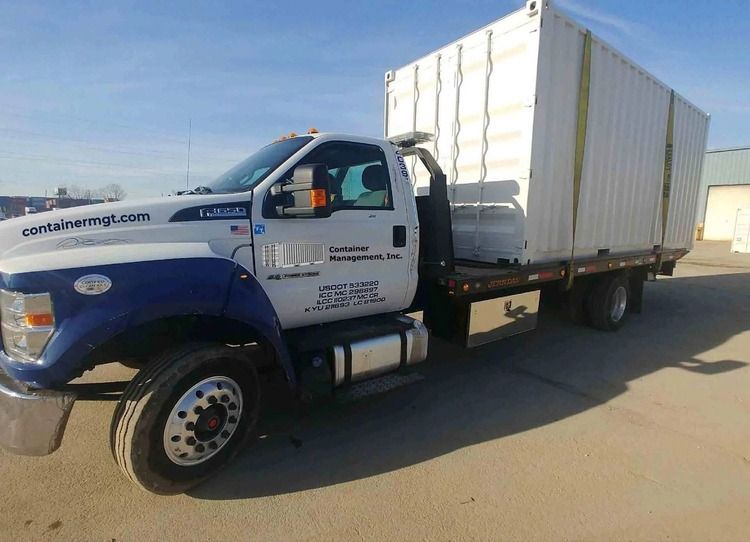See our related article:
Shipping Container Buying Guide: What You Need To Know
Written by Susan Nalevac | Updated September 16 , 2024
Shipping containers are the backbone of global logistics, known for their durability, versatility, and ability to transport goods across land and sea. Beyond traditional shipping, these containers serve countless purposes, including storage, office space, retail units, and even homes.
Whether you’re in the market for a container for shipping, storage, or an innovative repurposing project, this guide will help you make an informed decision on whether to buy new or used. We’ll explore container sizes, grades, flooring, and how to get the best container delivered to your location.
In this Article
Choosing Between New and Used Containers: Which is Right for You?
The decision to buy a new or used shipping container largely depends on your intended use, budget, and aesthetic preferences. Each option has distinct advantages that cater to different needs, making it important to weigh the pros and cons of both before making your decision.
New Containers (One-Trip)
New containers are in pristine condition, having made just one journey from their manufacturing facility overseas to a U.S. port. They are ideal for businesses needing aesthetically pleasing containers for storage, office conversions, or other high-visibility uses.
These containers offer the longest lifespan and require little to no maintenance upon delivery. Their fresh, rust-free appearance makes them especially attractive for retail or commercial applications where image matters.
Used Containers
Used containers are more affordable and environmentally friendly, making them a great choice for buyers on a budget or those prioritizing sustainability.
Available in grades like Cargo Worthy and Wind and Watertight, used containers can still serve reliably for storage or conversion purposes, though they may show cosmetic wear like rust, dents, or faded paint.
For many applications, such as on-site storage or workshop space, these containers provide excellent value without sacrificing functionality.
Container Sizes and Features
Shipping containers come in various sizes, each with its own set of dimensions, capacities, and potential uses. Understanding the differences between these sizes will help you select the container that best fits your specific needs. Here are the most common and readily available container sizes:
- 20-Foot Standard Containers: The most recognizable size, these containers are widely used for shipping and storage. Measuring 20 feet long, 8 feet wide, and 8 feet 6 inches tall, they are ideal for a range of uses, from transporting goods to being repurposed as storage units, workshops, or even pop-up businesses. With a maximum load capacity of 62,350 pounds, they provide a durable and reliable option for most needs.
- 40-Foot Standard Containers: Doubling the length of the 20-foot container, the 40-foot units maintain the same width and height, offering a larger capacity for storage or transportation. They are commonly used for larger storage needs, construction projects, and large-scale conversions. The increased size also makes them suitable for multi-container structures when used in conjunction.
- 40-Foot High Cube Containers: For applications requiring extra headroom, high cube containers offer an additional foot of height, standing 9 feet 6 inches tall. This added space makes them perfect for storing taller items, converting into livable spaces, or creating offices that need a bit more vertical clearance. High cube containers are popular in projects where maximizing internal volume is crucial.
Understanding Container Grades
The condition of a shipping container is critical, especially if you plan to use it for overseas shipping or long-term storage.
Containers are
graded based on their structural integrity and ability to protect their contents, which influences their suitability for different applications.
Cargo Worthy (CW)
These containers can pass inspection by a licensed maritime surveyor and can be certified for overseas shipping because they meet all the necessary criteria for transporting goods internationally and are considered structurally sound, even if they exhibit some minor cosmetic wear.
Cargo Worthy containers are perfect for anyone needing a reliable shipping solution or secure storage option.
Wind and Watertight (WWT)
Suitable for land-based storage, these containers prevent wind and water intrusion but are not eligible for certification for overseas shipping. They are often more affordable than Cargo Worthy containers while still providing robust protection for your goods.
WWT containers are a great option for on-site storage or conversion projects where shipping certification isn’t required.
As-Is
These containers come without any guarantees regarding their condition. They may have significant rust, floor damage, and other issues that impact their usability.
As-is containers are generally not recommended unless you are prepared to invest in repairs.
Note: Container Management, Inc. does not sell “As Is” containers.
Pros and Cons of Buying Used Shipping Containers
Purchasing a used shipping container can offer numerous benefits, especially for those who are budget-conscious or have specific environmental considerations in mind. However, there are also some drawbacks to keep in mind.
Pros:
- Cost-Effective: Used containers are typically 30-50% cheaper than new ones, making them an excellent option for buyers looking to save money. The reduced cost allows for additional spending on modifications, accessories, or other aspects of your project.
- Environmentally Friendly: By choosing used, you’re giving a container a second life and reducing demand for new production, which conserves resources and reduces carbon emissions associated with manufacturing and transporting new units.
- Durable: Even with prior use, these containers can last for decades when properly maintained. They are built to withstand harsh conditions, making them a durable choice for most applications, from storage to unique architectural projects.
Cons:
- Wear and Tear: Used containers may show signs of previous use, such as rust, dents, or fading. While these imperfections don’t usually affect functionality, they might not be ideal for aesthetic-focused projects or high-visibility applications where appearance matters.
Container Flooring
The flooring of shipping containers is designed to be tough, durable, and capable of withstanding heavy use. Most containers feature a floor composed of steel cross-beams topped with marine-grade plywood, which is specifically treated to resist moisture and damage.
- Marine-Grade Plywood: This plywood is often made from dense tropical hardwoods that provide excellent strength and resistance to decay. Treated to withstand water exposure, it can support heavy equipment like forklifts and pallet jacks without sustaining damage. The standard thickness of 1⅛ inches ensures it remains sturdy under pressure.
- Floor Maintenance and Upgrades: Over time, container floors may require maintenance, especially in older or heavily used units. Buyers can replace or reinforce flooring with steel plates or additional plywood layers for enhanced durability. If using the container for human occupancy or specialized storage, consider sealing or coating the floor to prevent chemical exposure or additional wear.
Getting Your Container Delivered
Once you’ve selected the perfect container, the final step is arranging for its delivery to your location. Understanding the logistics of container delivery can help ensure a smooth and timely arrival.
Nationwide Network
Container Management, Inc. operates a network of 32 depot sites and fabrication centers across the country, including major hubs in Houston and Chicago.
This extensive reach allows us to deliver containers quickly and efficiently to most locations, minimizing wait times and transportation costs.
Delivery Considerations
Before delivery, make sure you have ample space for the container truck to maneuver and unload. Most deliveries use tilt-bed trailers placing containers on the ground. Sometimes we will employ a flat-bed truck requiring customers to lift off containers at time of arrival.
Generally, flat-bed trucks requiring lift-off of containers by the customer are used for deliveries in excess of 200 miles. Ensure that the site is accessible and prepared for the weight of the container, especially if placing it on soft ground or elevated surfaces.
Customization and Modifications
If you need modifications such as doors, windows, or ventilation, consider having these changes made before delivery. Our fabrication centers can customize your container to your specifications.
As a result, we can ensure that it arrives ready for immediate use. Making these changes in advance saves you time and the hassle of making changes on-site.
Final Thoughts
Whether you opt for a new or used container, the key is to select a grade that meets your needs and a size that fits your space and intended purpose.
At Container Management, Inc., we provide a wide range of options to suit any project, from storage to conversions and everything in between.
Our expert team is here to guide you through the buying process and ensure you receive a container that’s perfect for your needs.
Contact us today to find the right container for you!






